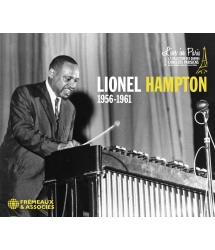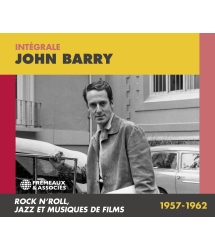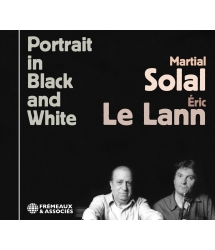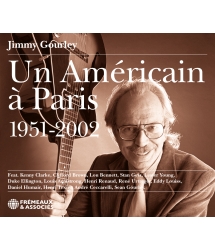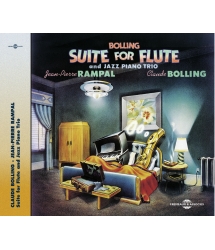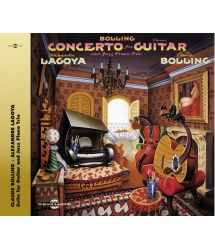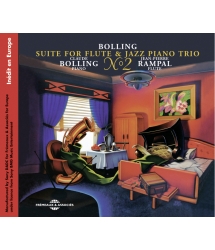- Our Catalog
- Philosophy
- Philosophers of the 20th century and today
- History of Philosophy (PUF)
- Counter-History and Brief Encyclopedia by Michel Onfray
- The philosophical work explained by Luc Ferry
- Ancient thought
- Thinkers of yesterday as seen by the philosophers of today
- Historical philosophical texts interpreted by great actors
- History
- Books (in French)
- Social science
- Historical words
- Audiobooks & Literature
- Our Catalog
- Jazz
- Blues
- Rock - Country - Cajun
- French song
- World music
- Africa
- France
- Québec / Canada
- Hawaï
- West Indies
- Caribbean
- Cuba & Afro-cubain
- Mexico
- South America
- Tango
- Brazil
- Tzigane / Gypsy
- Fado / Portugal
- Flamenco / Spain
- Yiddish / Israel
- China
- Tibet / Nepal
- Asia
- Indian Ocean / Madagascar
- Japan
- Indonesia
- Oceania
- India
- Bangladesh
- USSR / Communist songs
- World music / Miscellaneous
- Classical music
- Composers - Movie Soundtracks
- Sounds of nature
- Our Catalog
- Youth
- Philosophy
- News
- How to order ?
- Receive the catalog
- Manifesto
- Dictionnary











- Our Catalog
- Philosophy
- Philosophers of the 20th century and today
- History of Philosophy (PUF)
- Counter-History and Brief Encyclopedia by Michel Onfray
- The philosophical work explained by Luc Ferry
- Ancient thought
- Thinkers of yesterday as seen by the philosophers of today
- Historical philosophical texts interpreted by great actors
- History
- Books (in French)
- Social science
- Historical words
- Audiobooks & Literature
- Our Catalog
- Jazz
- Blues
- Rock - Country - Cajun
- French song
- World music
- Africa
- France
- Québec / Canada
- Hawaï
- West Indies
- Caribbean
- Cuba & Afro-cubain
- Mexico
- South America
- Tango
- Brazil
- Tzigane / Gypsy
- Fado / Portugal
- Flamenco / Spain
- Yiddish / Israel
- China
- Tibet / Nepal
- Asia
- Indian Ocean / Madagascar
- Japan
- Indonesia
- Oceania
- India
- Bangladesh
- USSR / Communist songs
- World music / Miscellaneous
- Classical music
- Composers - Movie Soundtracks
- Sounds of nature
- Our Catalog
- Youth
- Philosophy
- News
- How to order ?
- Receive the catalog
- Manifesto
- Dictionnary
TOOT SUITE
CLAUDE BOLLING
Ref.: FA558
EAN : 3448960255820
Artistic Direction : Sony BMG music entertainment US
Label : Frémeaux & Associés
Total duration of the pack : 37 minutes
Nbre. CD : 1
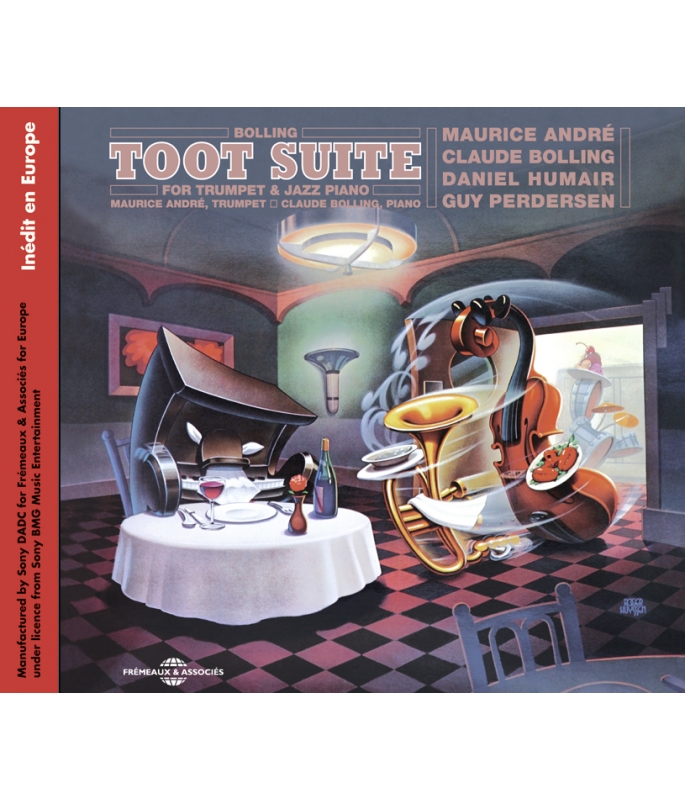
TOOT SUITE
TOOT SUITE
This Cd presents Claude Bolling “Toots Suite for trumpet & Jazz piano trio” with highly famed trompet player Maurice André.
-
PisteTitleMain artistAutorDurationRegistered in
-
1ALLEGRECLAUDE BOLLING00:06:231981
-
2MYSTIQUECLAUDE BOLLING00:07:491981
-
3RAG POLKACLAUDE BOLLING00:03:231981
-
4MARCHECLAUDE BOLLING00:06:401981
-
5VESPERALECLAUDE BOLLING00:07:111981
-
6SPIRITUELLECLAUDE BOLLING00:06:041981
TOOT SUITE
CLaude Bolling
TOOT SUITE
TOOT SUITE
1. ALLÈGRE 6:23
2. MYSTIQUE 7:49
3. RAG POLKA 3:23
4. MARCHE 6:40
5. VESPÉRALE 7:11
6. SPIRITUELLE 6:04
Claude BOLLING : Piano
Maurice André : Trumpet
Guy PEDERSEN : Double bass
Daniel HUMAIR : Drums
All compositions by Claude Bolling / Recorded?in / Enregistré au : Studio Davout, Paris / Sound Engineer / Ingénieur du Son : Claude Ermelin
Notes à propos de l’œuvre?:
1. ALLEGRE?: Ecrit pour trompette en do. Le thème classique est un canon. La partie rythmique est écrite en 6/8 et en 3/4. Written for the very classical C trumpet. The classical theme is a “canon”. The rythmic part is written in 6/8 and 3/4 time.
2. MYSTIQUE?: Construite sur un rythme en 12/8, cette magnifique mélodie d’inspiration baroque est suivie d’une variation à la trompette et au piano, puis par un développement avant de revenir au thème. Based on a 12/8 time rhythm, this beautiful melody of baroque inspiration is followed by a variation on trumpet and piano, then by a development before returning to the theme.
3. RAG-POLKA?: Maurice André voulait se remémorer ses débuts au cornet dans la fanfare des mineurs de son village natal. La “Polka à variation” était un genre très populaire en Allemagne et en France au début du XXème siècle. Elle est ramenée dans se morceau à ses racines communes avec le Ragtime. Maurice André wanted to recall his debut on the cornet in the minor brass band of his native village. The Polka à variations was a very popular genre in Germany and France in the early 20th century, which here returns to its common roots with ragtime.
4. MARCHE?: La trompette Piccolo est superbement exploitée par Maurice André dans ce morceau dont la deuxième partie tourne allègrement à la marche de Jazz. The Piccolo trumpet is wonderfully exploited by Maurice André in this piece where the second part merrily turns into a jazz march.
5. VESPERALE?: Maurice André a également voulu se confronter au “Flügelhorn”, un instrument actuellement en vogue chez les trompettistes. Comparé à l’éclat des registres élevés de la trompette piccolo du mouvement précédent, le flügelhorn donne ici à entendre toute la maturité et la profondeur de sa beauté. Maurice André also requested himself on the flügelhorn, an instrument increasingly favored by modern trumpeters. In contrast to the brilliance of the upper register of the piccolo trumpet in the precedong movement, the flüglhorn is heard here in all the mellowness and depth of its beauty.
6. SPIRITUELLE?: Ce dernier mouvement est basé sur une structure à 9 temps divisé en 4/4, 3/4, 2/4, puis concentrée en un 9/8 (4/8, 3/8, 2/8) qui devient finalement une structure de blues sur tempo rapide en 12 mesures. Conclusion magistrale de cette Toot Suite par Claude Bolling, qui met en valeur l’extraordinaire virtuosité de Maurice André. The last movement is based on a nine-beat time divided into 4/4, 3/4, 2/4 then concentrated into 9/8 (4/8, 3/8, 2/8) and finally becoming a fast twelve-bar blues. A magnificent conclusion to the Toot Suite by Claude Bolling, which pays homage to Maurice André’s outstanding virtuosity.
© 2006 SONY-BMG MUSIC ENTERTAINMENT / FRÉMEAUX & ASSOCIÉS
La Suite
La Suite for Flute and Jazz Piano, enregistrée avec Jean-Pierre Rampal en 1974, devint disque d’or – puis de platine – à la vitesse d’un cheval au galop?et est demeurée dans les premières place du Billboard (index des meilleures ventes américaines) durant 530 semaines?! Phénomène d’engouement extraordinaire, la création de Claude Bolling lançait un genre, le Cross-over music (métissage de la musique classique et du jazz) dont il sera le plus important représentant. Après ce succès, de grands solistes de musique classique réclamèrent à Claude Bolling de nouvelles Suites et concertos, dont la plupart allèrent rejoindre la première dans les sommets des charts américains. Claude Bolling écrivit avant tout ces œuvres pour proposer un dialogue entre des instrumentistes classiques et le jazz qu’il développe en France depuis le mileu des années 1940 avec un immense succès (doit-on rappeler que Duke Ellington considérait Claude Bolling comme un membre à part entière de sa famille musicale ?). Ces Suites donnaient en effet l’occasion à des musiciens d’horizons différents qu’un respect mutuel avait rapproché, de jouer ensemble. Maurice André, grand amateur de Dizzy Gillespie (et réciproquement) est l’instigateur de cette nouvelle Toot Suite for Trumpet and Jazz Piano. A sa demande, Bolling – spécialiste du ragtime et compositeur des musique de près de 100 films de premier plan (dont Borsalino et California Suite) – lui offre une œuvre qui captive musiciens et auditeurs par son originalité et son inventivité. La connaissance intime par Claude Bolling de chaque instrument, acquise par son expérience tant en jazz qu’en musique classique, lui a permis de créer une œuvre où Maurice André peut faire preuve de toute l’étendue de son talent. Celui-ci, dernier visiteur en date de l’univers musical de Bolling, prouve une nouvelle fois qu’il est parmi les plus grands trompettistes de notre temps. Il démontre dans cet enregistrement l’excellence de son phrasé et du son de sa trompette, la pureté de son attaque et sa maîtrise de la tormpette piccolo dont il est à l’origine du renouveau actuel.
© 2006 FRÉMEAUX & ASSOCIÉS
Claude Bolling’s Suite for Flute and Jazz Piano, recorded with Jean-Pierre Rampal in 1974, became the quickest Gold Record that CBS Masterworks ever issued and was still prominent on the recording industry’s Best Sellers charts 10 years after its issue. After this success, great classical soloists began clamoring for new suites and concertos from Bolling, some of wich leaped immediately to the top of best-selling charts and remained there for long periods of time. These compositions by Claude Bolling were written primarily to foster an exchange between classical instrumentalists and Claude Bolling’s traditional jazz piano (Duke Ellington considered the young Bolling a member of his own musical family). Further, the works were composed not as commercial ventures but as material for the use of musicians of diverse talents whose mutual respect had brought about an urge to perform together. Maurice André, a fan of Dizzy Gillespie (and vice versa) was the instigator of the new Toot Suite for Trumpet and Jazz Piano. Here again, Bolling – who is not only a ragtime specialist but also a top film score composer, with about 100 credits, including Borsalino and California Suite – has come up with a work that enthralls musicians and audience alike with its originality ad inventiveness. Claude Bolling’s intimate knowledge of musical instruments, acquired through his experience in both jazz and classical performances, has created a piece that has inspired Maurice André to exhibit the full range of his wide talent. André, the most recent visitor to Claude Bolling’s musical universe, once again proves himself to be the greatest classical trumpeter of our time. In his performance the listener can readily discern why when he experiences the quality of André’s tone and phrasing, the purity of his attack and, above all, his complete mastery of the piccolo trumpet, which he has popularized almost single-handedly.
© 2006 SONY-BMG MUSIC ENTERTAINMENT / FRÉMEAUX & ASSOCIÉS
Claude BOLLING
Six fois lauréat du Grand Prix du Disque en France, Claude Bolling a été plusieurs fois nominé aux Etats-Unis pour le Grammy Award et connaît depuis longtemps une célébrité internationale pour ses talents de compositeur, arrangeur, chef d’orchestre et pianiste. Né à Cannes, Claude Bolling s’est révélé à 14 ans comme un prodige du piano-jazz et a débuté très, tôt dans des activités professionnelles. Il avait reçu un solide enseignement de l’harmonie et du contrepoint, mais avait acquis la plupart de ses connaissances musicales en écoutant des disques. Ses premiers enregistrements ont été réalisés à 18 ans, avec son propre groupe de jazz Dixieland, et il est vite devenu l’un des musiciens de jazz les plus populaires d’Europe. Grâce à ses contacts fréquents avec de nombreux jazzmen américains expatriés en Europe dans les années 1950-60, Claude Bolling a cotoyé toute l’histoire du jazz au contact de ses plus grands innovateurs. Son guide en la matière fut Duke Ellington qui avait lui-même une grande admiration pour Bolling et appréciait énormément sa manière d’interpréter ses compositions. Compositeur prolifique, Claude Bolling a écrit plus d’une centaine de partitions pour la télévision et le cinéma, composant la musique de films comme “Borsalino”, “The Awakening”, “Willie et Phil”, “California Suite”, “The Silver Bears”, “Louisiane” et “Le Magnifique”. Claude Bolling a enregistré du ragtime, du boogie-woogie, du blues, des thèmes populaires, et il est surtout connu par ses propres compositions qui mêlent de façon unique la musique jazz, pop et classique. C’est ce style, connu sous le nom de “Crossover Music”, qui permit à Claude Bolling d’entrer dans l’histoire de la musique, avec la composition aujourd’hui célèbrissime “Suite pour Flûte et Piano Jazz Trio”. L’intérêt et l’engouement suscités, par la “Suite pour Flûte et Piano Jazz Trio” a incité d’autres musiciens classiques de premier ordre, tels que Pinchas Zukerman, Alexandre Lagoya, Yo-Yo Ma, Maurice André, Hubert Laws et l’English Chamber Orchestra, à rechercher les compositions de Claude Bolling pour leurs instruments respectifs. Bolling a répondu par une abondante production dans son style de Crossover Music, toujours basé sur le même trio, avec la “Suite pour Violon, le Concerto pour Guitare Classique, la Suite pour Violoncelle”, et bien d’autres ont suivi. Il dirige le plus célèbre Big Band de jazz européen, qui a déjà travaillé avec des musiciens et des chanteurs de jazz et de musique populaire aussi connus que Dizzy Gillespie, Lionel Hampton, Joe Williams, Carmen McRay, et récemment avec Stéphane Grappelli.
© 2006 FRÉMEAUX & ASSOCIÉS
Claude Bolling, six times a winner of the French Grammy award Le Grand Prix du Disque and nominated several times for the American Grammy, has received consistent international acclaim as a composer, conductor, arranger, and pianist. Born in Cannes, France, Bolling was recognized as a jazz piano prodigy at the age of 14 and soon began to make professional appearances. He had formal training in harmony and counterpoint, but acquired most of his musical education by listening to records. His first recordings were made with his own Dixieland group when he was 18, and he subsequently became one of the most popular jazz musicians in Europe. Bolling’s frequent contact with the numerous expatriate jazz musicians in Europe during the 1950’s and 60’s exposed him to the entire history of jazz as performed by its major innovators. His mentor was Duke Ellington, who greatly admired and praised Bolling’s interpretations of his compositions. A prolific composer, he has written over hundred scores for TV and feature films such as “Borsalino”, “The Awakening”, “Willie and Phil”, “California Suite”, “The Silver Bears”, “Louisiana” and “Le Magnifique”. olling has recorded ragtime, boogie-woogie, blues, popular standards, and most widely known, his own compositions in a unique mixture of pop, jazz, and classical styles. It was the latter style known commonly as “Crossover Music”, that enabled Bolling to make musical history with his by-now famous composition “Suite For Flute and Jazz Piano Trio”. The interest and excitement generated by “Suite For Flute and Jazz Piano Trio” promoted other leading classical musicians, including Pinchas Zukerman, Alexandre Lagoya, Yo-Yo Ma, Maurice André and the English Chamber Orchestra to seek Bolling composilions for their respective instruments. Bolling responded with a prolific output in his classical crossover style still based on his trio “Suite For Violin”, “Concerto For Classic Guitar”, “Suite For Cello”, and many others followed. He is leading the most famous European Jazz big hand which has worked with well known Jazz and popular instrumentalists and vocalists, including Dizzy Gillespie, Lionel Hampton, Joe Williams, Carmen McRay and recentily with Stéphane Grappelli.
© 2006 FRÉMEAUX & ASSOCIÉS
Maurice ANDRÉ
Maurice André est né en 1933 à Alès dans la région minière des Cévennes, en France. A l’âge de quatorze ans, il commença à travailler dans ces mines et se mit en même temps à étudier la trompette, dont il joua presque immédiatement à la perfection. Il reçut le Premier Prix d’honneur pour le cornet à pistons durant sa première année d’études au Conservatoire national de musique de Paris et l’année suivante obtint le Premier Prix pour la trompette. Il remporta ensuite une compétition internationale à Munich, ce qui déclancha une carrière internationale qui le mena en Allemagne, en Angleterre, en Scandinavie, en Amérique du nord et du sud. A présent, les chefs d’orchestre du monde entier se disputent la faveur de l’avoir comme exécutant. En 1967, André a été nommé professeur au Conservatoire national supérieur de musique de Paris. Maurice André a reçu en France un grand nombre de récompenses pour ses disques, et a récemment reçu le Deutscher Schallplatenpreis, qui est un tribut à l’immense popularité qu’il a acquise en Allemagne. Le critique allemand Harry Hallbreich a écrit?: “Maurice André est une incarnation de la Trompette. Nous en sommes arrivés à associer cet instrument à la voix d’or avec l’homme venu du sud de la France, aussi ouvert et jovial qu’il l’est, jaillissant du puits de mine de charbon vers la gloire et le succès. A l’âge de trente-six ans, il était acclamé dans le monde entier. Ses aptitudes et sa virtuosité sont profondément alliées à une qualité musicale parfaite et sa trompette a un chant qui résonne avec la pureté d’un violon. Il a dans un temps record exécuté l’ensemble d’un répertoire qui aurait, sans aucun doute, été plus riche si les grands compositeurs l’avaient connu ainsi que son talent. Il a redonné vie à une grand nombre de compositions étonnantes, comme le concerto de Hummel, et excelle aujourd’hui dans les transcriptions de musique classique pour la trompette.”
© 2006 FRÉMEAUX & ASSOCIÉS
Maurice André was born in 1933 in Alès in the mining area of the Cevennes, France. At the age of 14, he began to work in the mines there and at the same time took up the trumpet, at wich he excelled almost immediately. He was awarded the Premier Prix d’honneur in cornet during his first year of study at the Conservatoire National de Musique in Paris and the following year received the Premier Prix for the trumpet. He then won an international competition in Munich wich sparked an international career that took him to Germany, England, Scandinavia, North and South America.?Now orchestra conductors the world over are fighting for his performances. In 1967, andré was appointed professor of the Conservatoire National Supérieur de Musique in Paris. Maurice André has received a large number of record awards in France, and recently received the Deutscher Schallplatenpreis, which is a tribute to the immense popularity he has attained in Germany. German critic Harry Halbreich has written?: “Maurice André is the Trumpet incarnate. We have come to associate this golden instrument with the man from Southern France – broad and jovial as he his – bursting from the coal pit up to the glory of success. At 36, he was acclaimed the world over. His aptitude and virtuosity are deeply allied to a perfect musical quality and his trumpet sings out with the purity of a violin. He has quickly run through a repertoire which would no doubt have been a lot richer had the great composers known of him and his talent. He has brought to life a great number of astonishing compositions, such as the Hummel concerto, and today he excels in the transcriptions of classical music for trumpet.”
© 2006 SONY-BMG MUSIC ENTERTAINMENT / FRÉMEAUX & ASSOCIÉS
CD Toot Suite - Claude Bolling © Frémeaux & Associés (frémeaux, frémaux, frémau, frémaud, frémault, frémo, frémont, fermeaux, fremeaux, fremaux, fremau, fremaud, fremault, fremo, fremont, CD audio, 78 tours, disques anciens, CD à acheter, écouter des vieux enregistrements, albums, rééditions, anthologies ou intégrales sont disponibles sous forme de CD et par téléchargement.)
